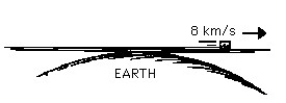Multiple Choice
Figure G-1

-Pretend an object is set sliding on a huge frictionless plane in contact with the surface of Earth as shown. Once the object is set in motion it will
A) theoretically slide to the right forever
B) slide back and forth
C) slow down and stop
Because
D) of its inertia.
E) gravitational force decreases with increasing distance.
F) the object is sliding "uphill" and then "downhill" relative to the round Earth.
Correct Answer:

Verified
Correct Answer:
Verified
Q177: Figure A-1<br> <img src="https://d2lvgg3v3hfg70.cloudfront.net/TB4073/.jpg" alt="Figure A-1
Q178: The thing that is different between x-rays
Q179: Figure A-4<br> <img src="https://d2lvgg3v3hfg70.cloudfront.net/TB4073/.jpg" alt="Figure A-4
Q180: Special relativity is most concerned with<br>A)uniform motion,<br>B)accelerated
Q181: Figure S-2<br> <img src="https://d2lvgg3v3hfg70.cloudfront.net/TB4073/.jpg" alt="Figure S-2
Q183: Atmospheric pressure is 10<sup>5</sup> N/m<sup>2</sup> at sea
Q184: A sports car and a moving van
Q185: Figure E-4<br> <img src="https://d2lvgg3v3hfg70.cloudfront.net/TB4073/.jpg" alt="Figure E-4
Q186: Light bends as it<br>A)passes a massive star,<br>B)traverses
Q187: Consider the fictional case of the incredible